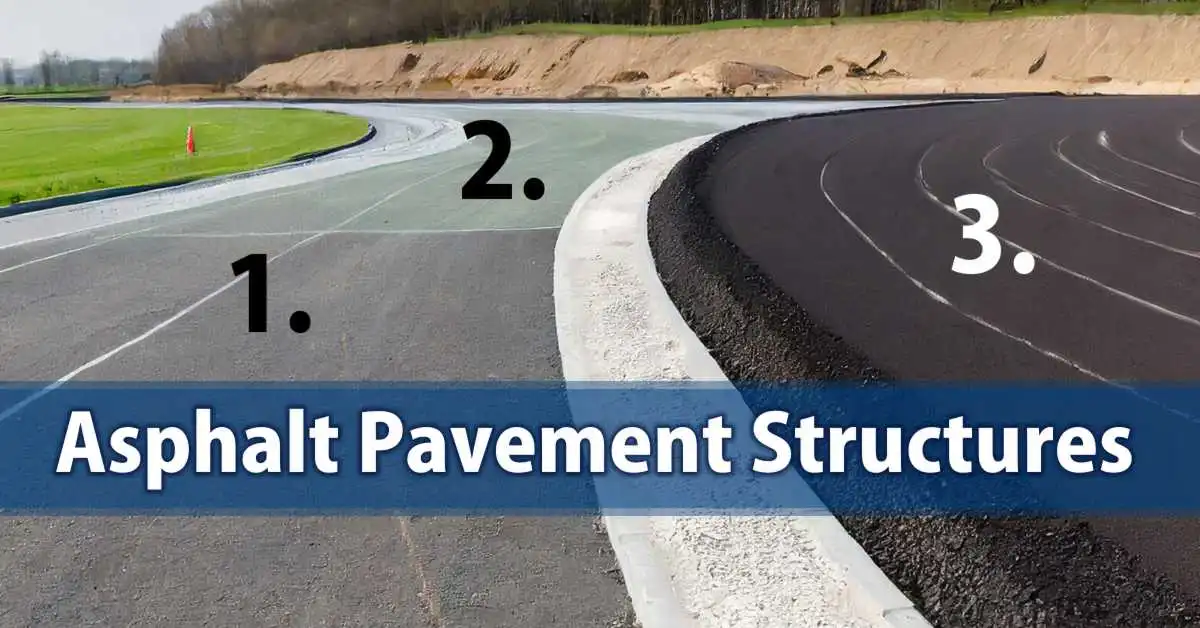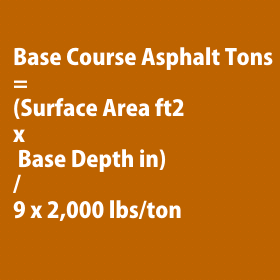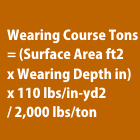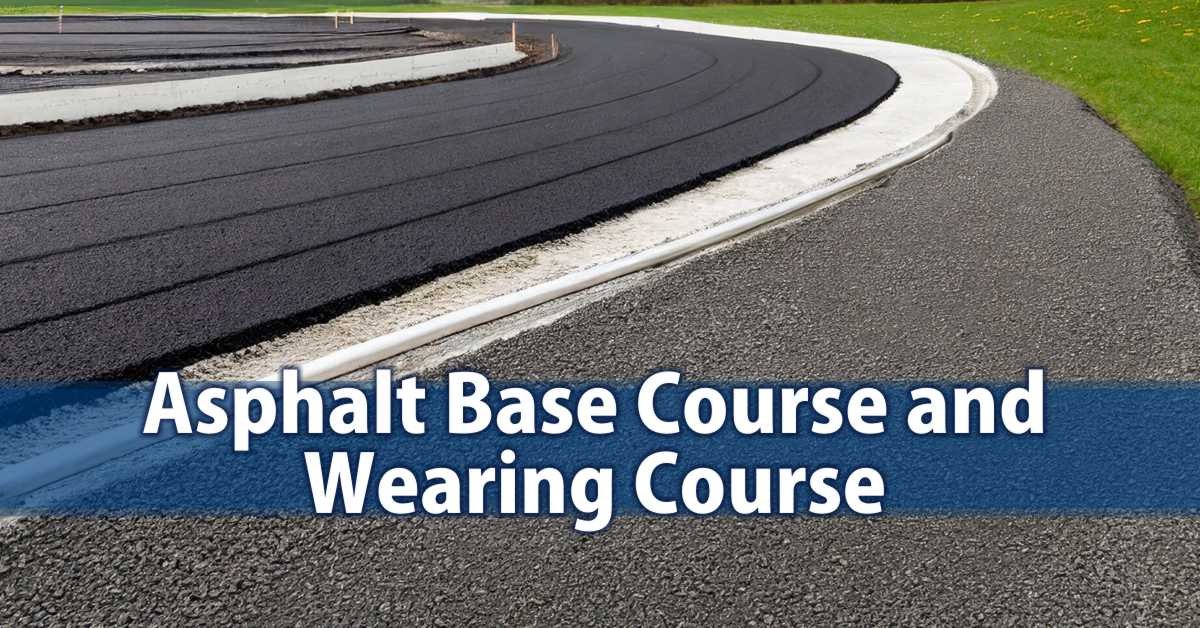[asphalt_base_course_abc_calculator]
Over my career, I’ve conducted hands-on investigations of hundreds of road sites, gaining invaluable knowledge examining actual pavement materials, layers, failures, and variables beyond the controlled conditions of the lab. By taking core samples, performing forensic analysis and testing, and evaluating performance data, I’ve gained irreplaceable observational insights into effective design, quality construction, and failure prevention. For paved roads, parking lots, driveways, and other asphalt surfaces, the pavement structure consists of several layers. The asphalt base course and wearing course represent the key asphalt layers in this system. Understanding their specific purposes, ideal materials, construction methods, and role in preventing failures ensures high-quality, long-lasting pavements.
Asphalt Pavement Structure Overview
The base course and wearing course provide independent but complementary functions that work together to provide long-term traffic load capacity, friction, and overall integrity. I and My crews follow strict processes for each piece, employing precision inputs and quality assurance testing to ensure long-term access and safety. Mastering both facets transforms pavement investment returns.

Asphalt Base Course Functions – Critical Load Bearing Zone
The underlying base course is composed of aggregate stone like Crushed stone, gravel, aggregate, sandstone, limestone, granite, trap rock, quartzite, dolomite, and basalt. Then the binding agents’ Bitumen, asphalt cement, tar, polymer-modified asphalt, and emulsified asphalt form a structural platform supporting vehicular traffic stresses affecting overall longevity and driving feel. This zone bears key responsibilities:
Distributes Loads Evenly:
Spreading concentrated vehicle tire forces laterally to the substrate subgrade prevents excessive compression or instability through wider displacement area
Resists Moisture Infiltration:
Impedes water seepage vertically into weaker subgrade zones ensuring retained bearing capacity and preventing freeze damage
Provides Stable Foundation:
Well-graded, interlocked angular stone pieces offer firm flat mounting surfaces for riding quality wearing courses despite subgrade anomalies
Extends Frost Protection Depth:
In colder climates, deeper base thickness protects pavement layers from frost heave effects below
Enables Gradual Stress Relief:
Ductile binder material joining aggregate allows minute deflections absorbing shear impact without fractures to overlay
Bridges Minor Voids:
Spans localized soft subgrade spots through structural continuity maintaining flexural rigidity
Promotes Drainage:
Permeability lets subsurface water bypass to beyond edges avoiding hydrostatic pressures
Achieving optimal asphalt road outcomes demands thick, quality base course installation aligned to traffic volumes and environmental conditions.
My professional design guidance weights parameters like hitherto soil California Bearing Ratios, annual freeze-thaw exposure, commercial vehicle fractions including occasional overload permits, 25+ year projected traffic gains, desired global roughness indexes, and client budget ceilings.
Asphalt Base Course Calculation Formula
Base Course Asphalt Tons = (Surface Area ft2 x Base Depth in)/9 x 2,000 lbs/ton


Precision inputs beget precision outputs! Now let’s examine wearing course counterparts.
In my experience, Here is the optimal base course thickness recommendations for all the project types you listed:
- Driveway:
- Light Traffic, Well-Graded Gravel: 4 inches
- Light Traffic, Sandy Soil: 6 inches
- Light Traffic, Silty Soil: 8 inches
- Heavy Traffic, Well-Graded Gravel: 6 inches
- Heavy Traffic, Sandy Soil: 8 inches
- Heavy Traffic, Silty Soil: 10 inches
- Parking Lot:
- Light Traffic, Well-Graded Gravel: 6 inches
- Light Traffic, Sandy Soil: 8 inches
- Light Traffic, Silty Soil: 10 inches
- Heavy Traffic, Well-Graded Gravel: 8 inches
- Heavy Traffic, Sandy Soil: 10 inches
- Heavy Traffic, Silty Soil: 12 inches
- Sidewalk:
- Light Traffic, Well-Graded Gravel: 4 inches
- Light Traffic, Sandy Soil: 6 inches
- Light Traffic, Silty Soil: 8 inches
- Road:
- Heavy Traffic, Well-Graded Gravel: 10 inches
- Heavy Traffic, Sandy Soil: 12 inches
- Heavy Traffic, Silty Soil: 14 inches
- Patio:
- Light Traffic, Well-Graded Gravel: 4 inches
- Light Traffic, Sandy Soil: 6 inches
- Light Traffic, Silty Soil: 8 inches
- Walkway:
- Light Traffic, Well-Graded Gravel: 4 inches
- Light Traffic, Sandy Soil: 6 inches
- Light Traffic, Silty Soil: 8 inches
- Airport Runway:
- Extreme Traffic, Well-Graded Gravel: 12 inches
- Extreme Traffic, Sandy Soil: 14 inches
- Extreme Traffic, Silty Soil: 16 inches
- Tennis Court:
- Heavy Traffic, Well-Graded Gravel: 8 inches
- Heavy Traffic, Sandy Soil: 10 inches
- Heavy Traffic, Silty Soil: 12 inches
- Basketball Court:
- Heavy Traffic, Well-Graded Gravel: 8 inches
- Heavy Traffic, Sandy Soil: 10 inches
- Heavy Traffic, Silty Soil: 12 inches
- Playground:
- Heavy Traffic, Well-Graded Gravel: 6 inches
- Heavy Traffic, Sandy Soil: 8 inches
- Heavy Traffic, Silty Soil: 10 inches
- Bicycle Lane:
- Light Traffic, Well-Graded Gravel: 6 inches
- Light Traffic, Sandy Soil: 8 inches
- Light Traffic, Silty Soil: 10 inches
- Racetrack:
- Extreme Traffic, Well-Graded Gravel: 12 inches
- Extreme Traffic, Sandy Soil: 14 inches
- Extreme Traffic, Silty Soil: 16 inches
- Skatepark:
- Heavy Traffic, Well-Graded Gravel: 8 inches
- Heavy Traffic, Sandy Soil: 10 inches
- Heavy Traffic, Silty Soil: 12 inches
- Industrial Yard:
- Extreme Traffic, Well-Graded Gravel: 12 inches
- Extreme Traffic, Sandy Soil: 14 inches
- Extreme Traffic, Silty Soil: 16 inches
- Loading Dock Area:
- Extreme Traffic, Well-Graded Gravel: 12 inches
- Extreme Traffic, Sandy Soil: 14 inches
- Extreme Traffic, Silty Soil: 16 inches
Asphalt Wearing Course Purpose – Safe Friction Zone
As the visible wearing surface interfacing vehicles, the asphalt-wearing course bears distinct performance mandates centered on tire contact and driver perception including:
Delivers Immediate Friction
Very small tight aggregate gradations coupled with high binder proportions supply immediate grip for responsiveness
Enables Steering Control
Consistent texture depth, positive crown slopes, and lateral rightlessness bolster reaction fidelity
Sheds Surface Stormwater
Sufficient convex shaping transports rain off for safer visibility while permeating through to base layers
Protects Underlying Layers
Seals base course from oxidation aging, weathering erosion, and petrochemical drippings
Provides Smooth Rideability
Uniform compaction and stiffness minimize vibration harshness and noise intrusion
Resists Rutting Deformation
Shear-resistant warm mix modified binders prevent channelized tire tracking damage
Aesthetic Visual Appeal
Consistent mat textures and minimized color variance for neighborhood curb appeal
Optimal Wearing Course
In my experience, Here are the recommended wearing course thicknesses for the different project types:
- Driveway:
- Light Traffic: 2-3 inches
- Heavy Traffic: 3-4 inches
- Parking Lot:
- Light Traffic: 3-4 inches
- Heavy Traffic: 4-6 inches
- Sidewalk:
- Light Traffic: 2-3 inches
- Road:
- Residential Street: 4-6 inches
- Arterial Road: 6-8 inches
- Highway: 8-12 inches
- Patio:
- Light Traffic: 2-3 inches
- Walkway:
- Light Traffic: 2-3 inches
- Airport Runway:
- 12-18 inches
- Tennis Court:
- 4-6 inches
- Basketball Court:
- 4-6 inches
- Playground:
- Light Traffic: 2-3 inches
- Heavy Traffic: 3-4 inches
- Bicycle Lane:
- 2-3 inches
- Racetrack:
- 6-10 inches
- Skatepark:
- 4-6 inches
- Industrial Yard:
- Heavy Traffic: 6-8 inches
- Extreme Traffic: 8-10 inches
- Loading Dock Area:
- Heavy Traffic: 6-8 inches
- Extreme Traffic: 8-10 inches
The wearing course thickness is typically determined by the anticipated traffic load and the desired service life of the pavement.
Wearing courses represent the tip of the structural iceberg for pavements but their visibility magnifies consumer discernment exponentially. We engineer optimal friction, noise, and ride quality thresholds through tailored aggregate skeletons, polymer-modified asphalts, and field adjustments meeting program benchmarks.
Now that we’ve established the overarching functions, how exactly are thickness values determined?
Expert Approach for Calculating Asphalt Layer Depths
Over simplistic rules of thumb for asphalt depths contribute to the wide variability in roadway durability and consumer opinions on quality. Our crews rely on precision engineering models factoring in numerous transit user priorities.
Configuring Optimal Base Course Thickness
The thickness of the foundational base course layer derives from structural analysis of projected traffic spectrums weighed against soil conditions.
Key inputs include:
Equivalent Single Axle Loads (ESAL) – Modelled lifetime 18Kip truck pass levels
California Bearing Ratios (CBR) – Subgrade strength testing values
Frost Depth – Regional cold temperature penetration levels
Reliability Factor – Client longevity goals
When designing commercial parking lots or highway routes carrying heavy vehicle traffic, I carefully evaluate four pivotal criteria affecting long-term pavement durability:
Equivalent Single Axle Loads (ESALs)
This models the cumulative damage 18Kip standard truck axles inflict over a pavement’s lifetime. New interstate highways often spec over 10 million 18Kip ESALs, meaning 10M equivalent single axle passes are anticipated. Higher ESAL estimates increase structural demands, base thicknesses and steel requirements.
California Bearing Ratios (CBR)
Evaluating subsurface strength using CBR tests helps set structural number targets resisted before flexing or rutting occurs. CBR percentages between 3-7% require 12 inch aggregate bases before paving. But values above 10% may only need 4-6 inch bases.
Frost Depth
In northern freeze/thaw regions, soil moisture penetrates deep in winter, requiring thicker base layers to minimize heaving. Metro Boston sees over 4-foot frost lines, mandating 5-6-foot total roadway structure depths. By comparison, frost depth in Miami is zero.
Reliability Factor
Clients aim for design reliability factors around 95%, meaning a 5% statistical failure risk over the asset’s targeted functional lifespan. Airport tarmac lifespan goals usually exceed 20 years with steel-reinforced designs, whereas residential driveways may only need 10 years of reliability using simpler specifications.
Understanding interactions between these metrics is crucial when advising regional contractors on mix types, strength needs, and drainage infrastructure investments needed to withstand punishing loading patterns, soil conditions, and climate exposures over decades of service.
Plugging variables into the empirically proven AASHTO flexible pavement structural number formula determines a recommended combined asphalt thickness. We subtract out the intended wearing course depth to find the ideal base thickness.
Note this produces thicknesses > 4 inches often needed despite some owner pushbacks on material differentials from outdated regional agency assumptions. I educate clients to understand true long-term cost savings outweigh upfront premiums.
Revolutionizing Roads: Turning Carbon into Asphalt for a Greener Tomorrow
Dialing-In High-Performance Wearing Course Mixes
The wearing course sits vitally important – needing balancing act durability against surface stability. Our teams test assorted aggregate gradations and binder modifications to hit key thresholds:
Friction – Target macrotextures ≥0.8mm for wet grip
Noise – Seek sound absorption of ≥4 dB(A) dampening
Ride – Require overall IRI smoothness ≤1.5 m/km for comfort
Rutting – Mandate max impressions ≤10mm deep through harsh Hamburg testing exceeding field conditions
This data-driven approach avoids overgeneralizing mix specs which compromise key wearing surface functions.
By optimizing both structural base support and precision surface attributes, my crews confidently deliver exceptional asphalt roads exceeding client expectations for beauty, safety, and longevity.
Top 6 Proven Tips To Maximize the Lifespan of Your Crushed Asphalt Driveway
In-Depth Look at Asphalt Base Course
For instance, extracting and examining cores lets me directly assess issues like delamination, moisture infiltration, wear patterns, and material degradation often hidden beneath the surface.
Testing samples from failed sections in the lab provides data on factors contributing to problems like fatigue, rutting, and thermal cracking under site-specific loading and environmental conditions. The asphalt base course serves crucial structural and load-bearing functions as it provides.
Asphalt Base Course Specifications
| Specification | Details |
|---|---|
| Thickness and Strength Needs | – Enough depth to spread loads without overstressing subgrade. – High stability to resist movement under loads. |
| Aggregate Gradation Options | – Well-graded with a range of stone sizes for stability. – Open-graded with uniform stone size for short-term use. |
| Binder Specifications and Content | – Softer PG grade asphalt binder adequate for lower layer. – Lower binder content vs. wearing course but still fully coated. |
| Compaction Standards and Results | – Compacted to 92-96% of maximum theoretical density. – Provides strength and resists permanent deformation. |
Thickness and Strength Needs
- Enough depth to spread loads without overstressing subgrade
- High stability to resist movement under loads
Aggregate Gradation Options
- Well-graded with a range of stone sizes for stability
- Open-graded with uniform stone size for short-term use
Binder Specifications and Content
- Softer PG grade asphalt binder adequate for lower layer
- Lower binder content vs. wearing course but still fully coated
Compaction Standards and Results
- Compacted to 92-96% of maximum theoretical density
- Provides strength and resists permanent deformation
In the field, I’ve seen base course issues like inadequate compaction, poor drainage, and unstable materials under loads lead to cracking and rutting failures in the wearing course above.
Key Details on Asphalt Wearing Course
My expertise lies in this ability to marry engineering principles and analytical methods with practical knowledge only attained by touching, feeling, and analyzing the physical objects of study themselves – actual asphalt pavements subject to real-world use. The asphalt-wearing course bears traffic loads and provides a safe driving surface:
Asphalt Wearing Course Specifications
| Specification | Details |
|---|---|
| Thickness Based on Traffic | – Thicker for higher volume roads and heavy vehicle traffic. – Thinner for driveways, parking lots with lighter loads. |
| Aggregate Size, Shape, and Friction | – Smaller aggregate size for smoothness and friction. – Angular aggregate with rough texture for skid resistance. – Durable stone resists polishing from traffic wear. |
| Asphalt Binder Viscosity and Performance | – Stiffer PG grade binder to resist rutting and withstand climate. – Polymer-modified for strength, durability, and flexibility. |
| Achieving Target Air Voids | – Air voids in compacted asphalt around 4% by volume. – Allows flexibility to prevent cracks but not too high to oxidize. |
Asphalt Warning Course Calculation FORMULA
Wearing Course Tons = (Surface Area ft2 x Wearing Depth in) x 110 lbs/in-yd2 / 2,000 lbs/ton


Thickness Based on Traffic
- Thicker for higher volume roads and heavy vehicle traffic
- Thinner for driveways, parking lots with lighter loads
Aggregate Size, Shape, and Friction
- Smaller aggregate size for smoothness and friction
- Angular aggregate with rough texture for skid resistance
- Durable stone resists polishing from traffic wear
Asphalt Binder Viscosity and Performance
- Stiffer PG grade binder to resist rutting and withstand climate
- Polymer-modified for strength, durability, and flexibility
Achieving Target Air Voids
- Air voids in compacted asphalt around 4% by volume
- Allows flexibility to prevent cracks but not too high to oxidize
From repairing badly raveled and rutted wearing courses, I’ve seen how poor aggregates, insufficient thickness, and bad mix designs can lead to premature deterioration.
Constructing Durable Asphalt Layers
Careful installation of the subgrade, base, and wearing course prevents issues:
Subgrade Prep Best Practices
- Eliminate organic material and soft soils
- Compact to 95% Proctor density evenly across the site
Base Course Installation Methods
- Moisture-condition materials before spreading and compacting
- Use vibratory rollers for breakdown then finish rolling
Wearing Course Paving Tips
- Ensure hot mix temperature meets viscosity needs for compaction
- Use a joint sealant to prevent water intrusion between passes
Aggregate Base Course Under Asphalt
Well-graded aggregate laid above the subgrade and below asphalt distributes loads while providing stability.
Aggregate Base Tons = (Surface Area ft2 x Agg. Base Depth in) x 1.4 tons/yd3 / 27 ft3/yd3
Key specifications and properties
Aggregate Base Course under asphalt and Crushed Gravel Base, highlighting their importance in creating a robust foundation for driveways and roadways.
| Property | Aggregate Base Course (ABC) Under Asphalt | Crushed Gravel Base |
|---|---|---|
| Material | Crushed Aggregate | Crushed Gravel |
| Gradation | Well-graded with a range of sizes | Well-graded with a range of sizes |
| Particle Size Distribution | Typically 1.5 inches down to fines | Typically 1.5 inches down to fines |
| Compaction Requirement | 95% Proctor Density | 95% Proctor Density |
| Permeability | Low | Moderate to High |
| CBR (California Bearing Ratio) | Minimum 80 | Varies based on gravel type and compaction |
| Thickness | As per design requirements | As per design requirements |
| Purpose | Provide a stable foundation for asphalt | Foundation for driveways and roadways |
| Drainage | Adequate drainage to prevent water buildup | Good drainage properties |
| Construction Process | Placed and compacted in layers | Placed and compacted in layers |
| Key Advantages | Enhances pavement stability and longevity | Provides a solid foundation for driveways |
Tack Coat Application Rates in Layers
A tack coat applied between lifts of asphalt cement layers together. Typical application rates are:
- 0.05 gal/yd2 between base and wearing course
- 0.03 gal/yd2 between layers of base course
The key is optimizing each layer’s thickness and materials to achieve targeted road performance properties through the combined pavement section depth. In the real world, things like poor subsurface drainage, construction delays, and inexperienced contractors can still undermine quality despite textbook methods.
Preventing Premature Asphalt Failures
| Preventive Measures | Common Causes |
|---|---|
| Rutting and Cracking Causes | – Insufficient thickness and compaction. – Poor mix of design and materials. |
| Moisture Damage Prevention | – Quality drainage and moisture barriers. – Seal cracks and joints promptly. |
| Importance of Bonding Layers | – Tack coat between all layers. – Avoid dirt, debris, and moisture during paving. |
With diligence, common asphalt issues like cracking and rutting can be reduced:
Rutting and Cracking Causes
- Insufficient thickness and compaction
- Poor mix of design and materials
Moisture Damage Prevention
- Quality drainage and moisture barriers
- Seal cracks and joints promptly
Importance of Bonding Layers
- Tack coat between all layers
- Avoid dirt, debris, and moisture during paving
No amount of site control and prevention can entirely account for variables like weather delays, changing subgrade conditions over time, and human factors in construction execution.
Final Words
The asphalt base course and wearing course each serve vital functions within pavement structures. Following standards for materials, mix design, construction, drainage, and maintenance minimizes the risk of premature failures from issues like rutting, cracking, and raveling. However, successfully executing quality field installations involves adapting plans to address real-world conditions and variables that textbooks cannot cover.
Taking a balanced approach leveraging both academic guidelines and practical experience ultimately results in durable, long-lasting asphalt layers.
Answering The Questions
What thickness is typical for an asphalt base course?
Base course thicknesses range from 4-12 inches. 6 inches is common for roads and parking lots. Driveways may use 4 inches. Heavy traffic needs thicker bases.
What is the difference between open-graded and well-graded base courses?
Open-graded means more uniform aggregate sizes with gap gradation. Well-graded uses a wide range of stone sizes for dense gradation. Open-graded offers some drainage.
How much asphalt binder is usually used in the base mix?
Base courses normally use 4-6% asphalt binder by weight. This is less than the 5-7% often used in wearing courses since it does not need as much durability.
What causes asphalt-wearing courses to rut in wheel paths?
Insufficient thickness and weak base materials are common rutting causes. Excessive binder content in the mix, poor compaction, and soft aggregates can also contribute.
How soon can traffic be allowed on the new asphalt-wearing course?
It’s best to wait 24 hours for compaction and cooling before opening to traffic. Heavy vehicles may need 48-72 hours. Quicker openings can cause permanent marks or distress.
